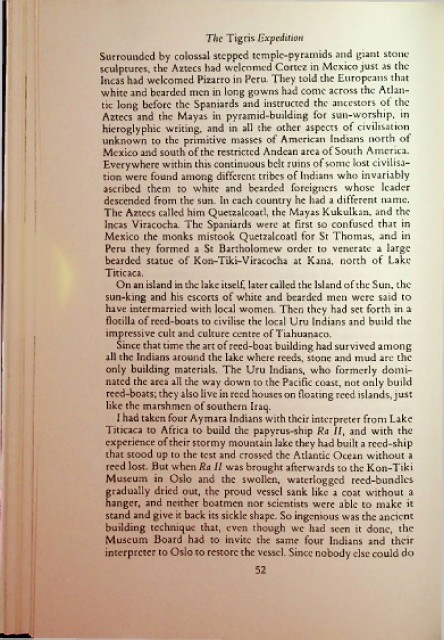Page 63 - The Tigris Expedition
P. 63
The Tigris Expedition
Surrounded by colossal stepped temple-pyramids and giant stone
sculptures, the Aztecs had welcomed Cortez in Mexico just as the
Incas had welcomed Pizarro in Peru. They told the Europeans that
white and bearded men in long gowns had come across the Atlan
tic long before the Spaniards and instructed the ancestors of the
Aztecs and the Mayas in pyramid-building for sun-worship, in
hieroglyphic writing, and in all the other aspects of civilisation
unknown to the primitive masses of American Indians north of
Mexico and south of the restricted Andean area of South America.
Everywhere within this continuous belt ruins of some lost civilisa
tion were found among different tribes of Indians who invariably
ascribed them to white and bearded foreigners whose leader
descended from the sun. In each country he had a different name.
The Aztecs called him Quetzalcoatl, the Mayas Kukulkan, and the
Incas Viracocha. The Spaniards were at first so confused that in
Mexico the monks mistook Quetzalcoatl for St Thomas, and in
Peru they formed a St Bartholomew order to venerate a large
bearded statue of Kon-Tiki-Viracocha at Kana, north of Lake
Titicaca.
On an island in the lake itself, later called the Island of the Sun, the
sun-king and his escorts of white and bearded men were said to
have intermarried with local women. Then they had set forth in a
flotilla of reed-boats to civilise the local Uru Indians and build the
impressive cult and culture centre of Tiahuanaco.
Since that time the art of reed-boat building had survived among
all the Indians around the lake where reeds, stone and mud arc the
only building materials. The Uru Indians, who formerly domi
nated the area all the way down to the Pacific coast, not only build
reed-boats; they also live in reed houses on floating reed islands, just
like the marshmen of southern Iraq.
I had taken four Aymara Indians with their interpreter from Lake
Titicaca to Africa to build the papyrus-ship Ra //, and with the
experience of their stormy mountain lake they had built a reed-ship
that stood up to the test and crossed the Atlantic Ocean without a
reed lost. But when Ra II was brought afterwards to the Kon-Tiki
Museum in Oslo and the swollen, waterlogged reed-bundles
gradually dried out, the proud vessel sank like a coat without a
hanger, and neither boatmen nor scientists were able to make it
stand and give it back its sickle shape. So ingenious was the ancient
building technique that, even though we had seen it done, the
Museum Board had to invite the same four Indians and their
interpreter to Oslo to restore the vessel. Since nobody else could do
52

